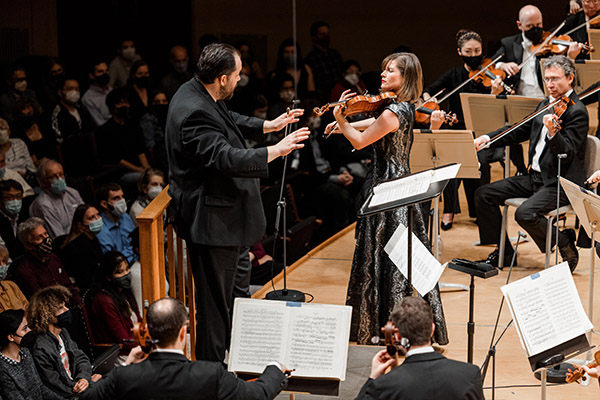BSO, Nelsons draw together disparate works from luminous Strauss to blazing Sibelius

Lisa Batiashvili played the Sibelius Violin Concerto with Andris Nelsons conducting the Boston Symphony Orchestra Thursday night. Photo: Aram Boghosian
Music, like politics, sometimes makes for strange bedfellows. At least that’s how Thursday night’s concert from the Boston Symphony Orchestra and music director Andris Nelsons appeared on paper. Juxtaposing works by William Grant Still, Richard Strauss, and Jean Sibelius, this was one of the young season’s intriguing lineups.
In practice, though, there were subtle connections tying these three composers together.
Strauss, who was represented by his “Symphonic Fantasy” on Die Frau ohne Schatten, conducted the premiere of the final version of Sibelius’s Violin Concerto – the night’s closing event – in Berlin in 1905. Still and Sibelius were mutual admirers; the former’s Threnody (In Memory of Jan Sibelius) was written eight years after the Finnish master’s death.
More poignant and reflective than dirge-like, Still’s 1965 essay, which opened the evening, alternates a stately tramping figure with a warmly lyrical and vaguely bluesy melodic refrain. In just six minutes, Threnody makes a number of allusions – to the African-American spiritual tradition, Shostakovich, and jazz, among others – but it defies easy stylistic categorization.
Nelsons drew a soulful performance from his forces in this touching, if slight, piece. The music’s songful climaxes, in particular, were plush-toned, while its recurring tattoos snapped smartly.
Rhythmic precision and expressive intensity were also hallmarks of the evening’s performance of the Sibelius Violin Concerto. Perhaps the 20th century’s first great violin concerto, Thursday’s reading emphasized the music’s tempestuous extremes.
Nelsons ensured that the orchestral parts’ mighty contrasts of dynamics – from biting outbursts to concentrated, fragile pianississimos – were all strongly etched. So, too, the score’s shifting textural and rhythmic foundations.
Meanwhile, soloist Lisa Batiashvili delivered a blazing account of the solo part. A violinist whose playing combines poetry and fire in equal measure, her performance Thursday shimmered from the start. Her initial entrance floated over the nervous orchestral trills underneath like velvet on lace, and grew in rhapsodic power from there.
The slow movement sang fervently, with Batiashvili’s solo line buffeted – but never covered – by the BSO. In the finale, she mined the music’s demoniacal undercurrents with aplomb: this was, by turns, a playful, mocking, and dancing interpretation, never settled or predictable.
Afterwards, the violinist rewarded the audience’s rousing ovation with an encore of Alexi Machavariani’s motoric Doluri. Written in 1980, this two-minute moto perpetuo showpiece is full of driving double-stops and brief moments of repose. In addition to the fireworks, Batiashvili deftly brought out the folk-music elements, echoing the same quality latent in the Still and Sibelius works.
Essentially a potpourri on themes from Strauss’s 1919 opera, Die Frau ohne Schatten, this 1946 “Symphonic Fantasy” condenses the stage work’s three-plus-hour runtime into a trim twenty minutes.
While one can appreciate this suite without delving into its mythic and labyrinthine plot (two couples learn the benefits of self-denial and -sacrifice after undergoing various trials), Strauss, curiously, omitted some of his more daring and dissonant writing in this “Fantasy.” As a result, the piece, though lush and lyrical, can seem oddly insubstantial, lacking a strong sense of musical contrast and dramatic tension.
Not so on Thursday. Nelsons led a reading that was smartly paced, wonderfully balanced, and tightly focused. Of the score’s many, moving inner voices, only its important motivic materials consistently emerged in the foreground. As a result, the music sounded conspicuously well-directed and purposeful.
What’s more, Nelsons managed its several transitions flawlessly, and the work’s discursive structure held together tightly.
This allowed the BSO, which was performing the piece for the first time, to treat Strauss’s lucid and luminous orchestral writing as the veritable playground that it is. Accordingly, the score’s striking moments – like the English horn-and-trombone setting of “Mir anvertraut” – glowed. At the same time, its bold strokes, which culminate in the radiant transformation music from Act 3, blazed fiercely.
The program will be repeated 1:30 p.m. Friday and 8 p.m. Saturday and Tuesday at Symphony Hall. Tuesday’s performance substitutes Bartók’s Concerto for Orchestra for the Sibelius. bso.org; 888-266-1200.
Posted in Performances